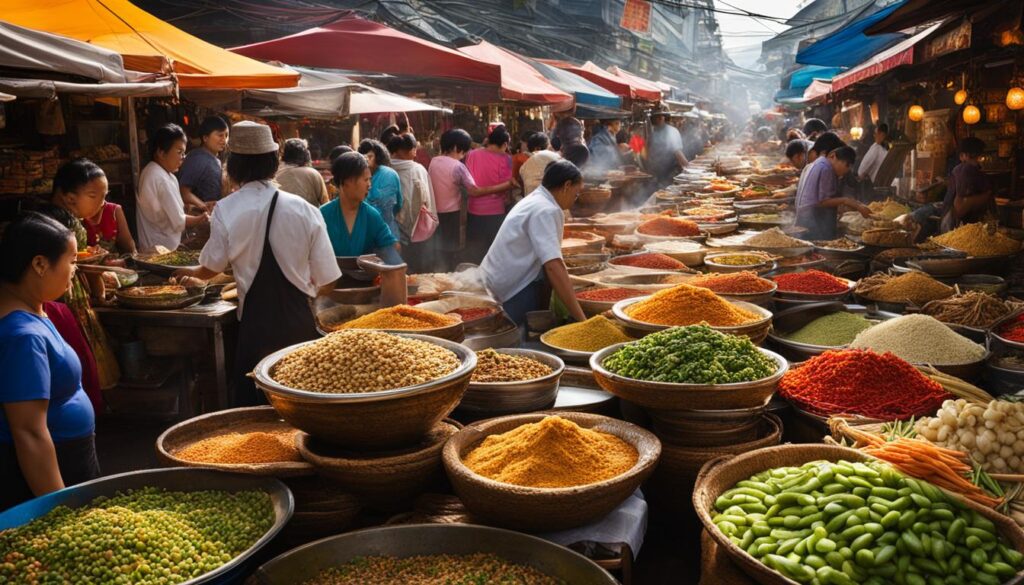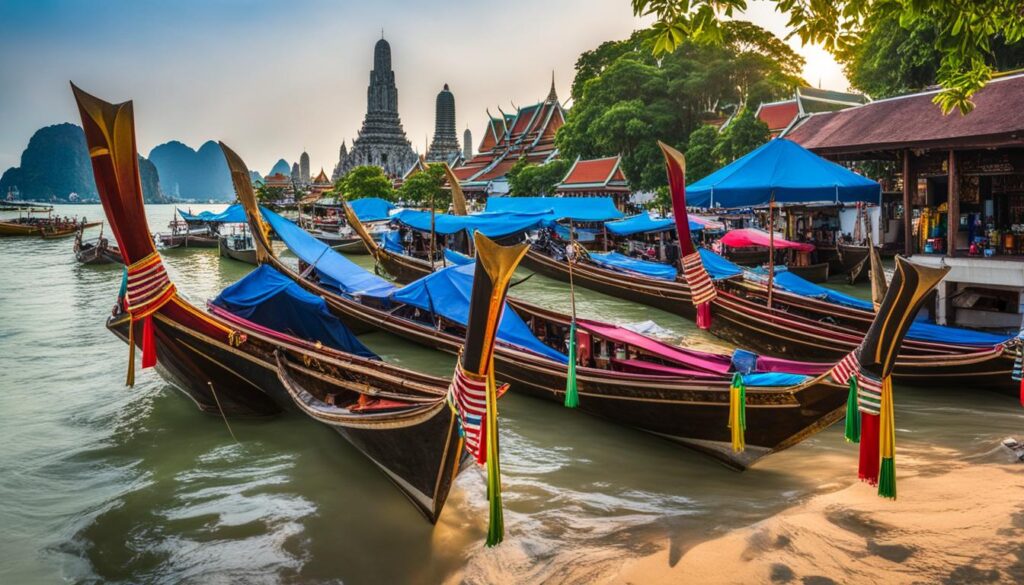Thailand is a popular travel destination known for its beautiful beaches, vibrant culture, and delicious cuisine. Whether you’re planning a budget-friendly trip or a luxurious vacation, it’s important to understand the costs associated with traveling to Thailand.
Accommodation, transportation, food, and activities are all factors that contribute to the overall expense of your trip. By gaining insight into the costs involved, you can plan your itinerary and budget accordingly, ensuring a stress-free and enjoyable experience.
In this section, we will explore the different costs associated with traveling to Thailand, providing you with a comprehensive understanding of the expenses involved in planning your trip. We’ll cover everything from budget-friendly options to luxurious indulgences, so you can plan the perfect trip for your preferences and budget.
So, if you’re wondering “How much does it cost to travel to Thailand?” we have you covered. Let’s dive into the details and start planning your unforgettable trip to Thailand.
Planning your Trip: How many days do I need in Thailand?
To make the most out of your trip to Thailand, it’s important to plan your itinerary wisely. With so many incredible sights and experiences to enjoy, you’ll want to ensure that you have enough time to see and do everything on your list. So, how many days do you need for a trip to Thailand?
The ideal duration for a trip to Thailand depends on several factors, including your budget, travel style, and the destinations you want to visit. However, we recommend spending a minimum of 10 days to truly experience the best that Thailand has to offer.
Of course, if you have more time, you can explore the country more extensively and make room for some off-the-beaten-path destinations. A two-week trip to Thailand is a popular option, allowing you to visit the most iconic sights as well as some lesser-known gems.
When planning your Thailand itinerary, consider the amount of time you’ll need in each destination as well. Here are some recommended lengths of stay for popular destinations in Thailand:
| Destination | Recommended Length of Stay |
|---|---|
| Bangkok | 3-4 days |
| Chiang Mai | 3-4 days |
| Phuket | 3-4 days |
| Krabi | 2-3 days |
| Koh Samui | 3-4 days |
Keep in mind that this is just a rough guide, and you can adjust your itinerary depending on your interests and preferences. Whether you want to indulge in the vibrant nightlife of Bangkok, relax on the beaches of Phuket, or explore the rich cultural heritage of Chiang Mai, there’s something for everyone in Thailand.
So, when planning your Thailand trip, aim for a duration of at least 10 days to ensure a comprehensive experience. Research your desired destinations, consider their recommended length of stay, and tailor your itinerary to your interests and budget. With the right amount of planning, you can create an unforgettable vacation to the Land of Smiles.
Accommodation: Finding the Right Place to Stay
Thailand offers a variety of accommodation options to fit any budget and style of travel. Whether you’re looking for cost-effective hotels, budget-friendly accommodations, or luxury resorts, there is something for everyone. Here are some of the top accommodation options to consider:
Thailand Hostels
Hostels are a popular option for budget-conscious travelers and backpackers. They offer a social atmosphere, communal areas, and affordable rates. Many hostels also offer private rooms for those who want a bit more privacy. Some popular hostel chains in Thailand include Hostelworld, Hostelbookers, and Hostelling International.
Cost-effective Hotels in Thailand
If you’re looking for something a bit more private than a hostel, you can find cost-effective hotels throughout Thailand. These hotels offer comfortable rooms and basic amenities at affordable prices. Some popular hotel chains in Thailand include Ibis, Holiday Inn Express, and Premier Inn.
Budget-friendly Accommodations in Thailand
For those who want to save even more money, there are plenty of budget-friendly accommodations in Thailand. Guesthouses, homestays, and apartments are just a few options to consider. These accommodations offer a more local experience and the opportunity to live like a local.
Luxury Resorts in Thailand
Thailand is also home to some of the world’s top luxury resorts. From beachfront villas to spa retreats, these resorts offer the ultimate in relaxation and pampering. Some popular luxury resort chains in Thailand include Four Seasons, Banyan Tree, and COMO Hotels & Resorts.
No matter what type of accommodation you choose, be sure to do your research and read reviews before booking. This will ensure that you find the best place to stay in Thailand for your needs and budget.
Transportation: Getting around in Thailand
Getting around in Thailand is an important part of your trip. There are several transportation options available, including public transportation, taxis, and renting a scooter.
Thailand transportation options
Thailand has a well-developed transportation system that makes it easy to get around the country. Some of the most common transportation options include:
- Public transportation
- Taxis
- Motorbike and scooter rentals
- Tuk-tuks
- Private car rentals
Each transportation option has its pros and cons, so it’s important to consider which one is best for your itinerary and budget.
Cost of transportation in Thailand
The cost of transportation in Thailand varies depending on the mode of transport you choose. Generally, public transportation is the cheapest option, while taxis and private car rentals can be more expensive.
Here is a breakdown of the approximate costs of different transportation options:
| Transportation Option | Approximate Cost |
|---|---|
| Local bus or train | $0.50 – $2 USD |
| Tuk-tuk | $2 – $5 USD |
| Taxi | $5 – $20 USD |
| Scooter rental | $5 – $20 USD per day |
| Private car rental with driver | $50 – $100 USD per day |
Public transportation in Thailand
Public transportation in Thailand is a cheap and efficient way to get around the country. Some of the most common forms of public transportation include:
- Local buses
- Trains
- Songthaews (pickup trucks with benches in the back)
Local buses and trains are the cheapest option, with fares ranging from $0.50 to $2 USD depending on the distance traveled. Songthaews are also a popular mode of public transportation and are commonly used in rural areas.
Taxis in Thailand
Taxis are a convenient way to get around Thailand, but they can be more expensive than public transportation. Make sure to negotiate the fare before getting in the taxi, as most taxis in Thailand don’t have a meter.
Renting a scooter in Thailand
Renting a scooter is a popular option for exploring Thailand, especially in rural areas. Scooters can be rented for as little as $5 USD per day, but make sure to wear a helmet and be aware of traffic conditions.
Overall, there are many transportation options available in Thailand, each with its pros and cons. Consider your budget and itinerary when choosing a transportation method, and make sure to stay safe and follow local driving laws.
Food and Drinks: Exploring Thai Cuisine
Thailand is a food lover’s paradise, with an array of flavors and dishes to tantalize your taste buds. From fragrant curries to spicy soups, Thai cuisine is a delicious and diverse mix of sweet, sour, salty, and spicy.
One of the best ways to experience Thai food is by trying the street food. You’ll find food vendors all over the country selling a variety of tasty treats, from savory pancakes to grilled meat skewers. The best part? It’s incredibly affordable, making it a great option for budget-conscious travelers.
If you’re looking for a more formal dining experience, Thai restaurants offer a wide selection of dishes to suit all tastes and budgets. Be sure to try some of the popular Thai dishes such as Pad Thai, Tom Yum Goong, and Massaman Curry. You can expect to pay anywhere from $5 to $25 per person, depending on the level of sophistication of the restaurant.
Thai food culture is centered around communal eating, with dishes served in the middle of the table for sharing. It’s also common to eat with a spoon and fork, with the spoon in your dominant hand and the fork in the other. Chopsticks are not commonly used in Thailand.
When trying local cuisine in Thailand, it’s important to be aware of the level of spiciness. Thai food is notorious for its heat, but many dishes can be adjusted to your liking. Don’t be afraid to ask for “mai pet” (not spicy) if you’re sensitive to heat.
Activities and Sightseeing: Making the most of your time in Thailand
Thailand offers a wealth of activities and sights to explore. Whether you’re interested in cultural experiences or outdoor adventures, there’s something for everyone.
Popular Tourist Attractions in Thailand
Some of the most popular tourist attractions in Thailand include:
- The Grand Palace and Wat Phra Kaew in Bangkok
- The ancient city of Ayutthaya
- The beaches of Phuket
- The temples of Chiang Mai
- The Bridge over the River Kwai in Kanchanaburi
Visiting these sights will give you a taste of Thailand’s rich cultural heritage and natural beauty.
Cost of Activities in Thailand
The cost of activities in Thailand can vary depending on what you choose to do. Here are some examples:
| Activity | Cost (in USD) |
|---|---|
| Elephant sanctuary visit | $60-$100 |
| Scuba diving trip | $60-$120 |
| Thai cooking class | $30-$50 |
| Zip-lining adventure | $50-$100 |
| Temple visit | Most temples have a small entrance fee (usually less than $5) |
Keep in mind that some activities, such as visiting national parks or hiring a tour guide, may have additional fees. It’s a good idea to research and budget accordingly.
Exploring Thai Culture
One of the highlights of visiting Thailand is immersing yourself in the rich culture. Here are some ways to experience Thai culture:
- Visit a local market and try street food
- Attend a traditional Thai dance performance
- Take a Thai language class
- Learn to cook Thai food
- Participate in a meditation or yoga retreat
Adventure Activities in Thailand
If you’re looking for adventure, Thailand has plenty of options:
- Scuba diving and snorkeling in the crystal-clear waters
- Zip-lining through the jungle
- Rock climbing in Railay Beach
- Trekking in the mountains of Chiang Mai or Chiang Rai
- White-water rafting in Pai
Visiting Temples in Thailand
Thailand is home to some of the most beautiful and iconic temples in the world. Here are a few you won’t want to miss:
- Wat Phra Kaew and the Grand Palace in Bangkok
- Wat Phra That Doi Suthep in Chiang Mai
- Wat Rong Khun (White Temple) in Chiang Rai
- Wat Arun (Temple of Dawn) in Bangkok
- Wat Pho (Temple of the Reclining Buddha) in Bangkok
Visiting these temples is a great way to learn about Thai history and culture.
With so many things to see and do, you’ll never be bored during your trip to Thailand!
Budgeting and Money: Managing your Expenses
Thailand is a popular destination for budget travelers, but it’s important to have a realistic understanding of the costs involved in planning your trip. By creating a travel budget, you can manage your expenses effectively and avoid any unexpected surprises along the way.
Thailand Travel Budget
The amount of money you’ll need for your Thailand trip will depend on a few factors, such as the duration of your stay, your accommodation preferences, and your planned activities. On average, you can expect to spend around $50-$70 per day. However, if you’re on a tight budget, it’s possible to get by on as little as $20-$30 per day.
Cost-Saving Tips for Thailand
Here are some tips to help you save money while traveling in Thailand:
- Choose budget-friendly accommodation options such as hostels or guesthouses.
- Eat local street food instead of dining at expensive restaurants.
- Consider taking public transportation or renting a scooter instead of relying on taxis.
- Take advantage of free activities such as visiting public parks or attending local festivals.
- Shop at local markets instead of touristy souvenir shops.
Managing Expenses in Thailand
Managing your expenses in Thailand is easy thanks to the widespread availability of ATMs. However, it’s important to inform your bank before your trip to avoid any issues with international transactions. The local currency is the Thai Baht (THB), and you can expect to get around 30 THB for $1 USD.
Currency in Thailand
When exchanging money in Thailand, it’s best to avoid hotels and tourist areas as they usually have higher exchange rates. Instead, head to local banks or currency exchange booths for the best rates. You can also withdraw cash from ATMs, but be aware of any additional fees charged by your bank.
ATM Availability in Thailand
ATMs are widely available in Thailand, especially in popular tourist areas like Bangkok and Phuket. However, it’s always a good idea to carry some cash with you, just in case you run into any issues with your cards.
Safety and Health: Staying Safe and Healthy in Thailand
Thailand is a relatively safe country for travelers, but it’s always important to take precautions when traveling abroad. Here are some Thailand travel safety tips to keep in mind:
- Avoid carrying large sums of cash with you.
- Keep your valuables, such as your passport and money, in a secure location at all times.
- Be wary of strangers who approach you, especially in tourist areas.
- Use only licensed and metered taxis and be sure to agree on the fare before getting in.
- Always wear a helmet when riding a motorbike, and make sure your travel insurance covers this activity.
When it comes to health precautions in Thailand, it’s important to take the necessary steps to stay healthy during your trip:
- Drink bottled or filtered water to avoid getting sick from contaminated water.
- Use insect repellent to protect against mosquito-borne illnesses such as dengue fever and Zika virus.
- Be cautious when purchasing food from street vendors and make sure it’s cooked properly to avoid food poisoning.
- Get vaccinated before your trip and consider purchasing travel insurance that includes medical coverage.
Travel insurance for Thailand is highly recommended to protect against unforeseen circumstances such as medical emergencies, trip cancellations, and lost or stolen items. Make sure to purchase insurance that covers any activities you plan on participating in, such as motorbiking or adventure sports.
Unfortunately, there are some common scams in Thailand that tourists should be aware of. These can include taxi drivers trying to overcharge you, gemstone scams, and tuk-tuk drivers taking you to stores where they receive a commission for your purchases. To avoid these scams, always ask for prices up front, use reputable tour operators, and do your research before making any big purchases.
By following these Thailand travel safety tips and health precautions, you can enjoy a safe and worry-free trip to this incredible destination.
Cultural Etiquette: Respecting Thai Customs and Traditions
Thailand has a unique and rich cultural heritage that should be respected and revered by all visitors. As a guest in this beautiful country, it’s important to be familiar with local customs and traditions to avoid giving offense accidentally. Here are some tips for respecting Thai culture:
Dress Code in Thailand
Thailand has a hot and humid climate, but it’s essential to dress modestly and appropriately when visiting temples and other religious sites. Men should wear long pants and shirts with sleeves, and women should wear long skirts or pants and cover their shoulders. Avoid wearing shorts, tank tops, and revealing clothing when visiting religious sites.
Religious Customs in Thailand
Thailand is a predominantly Buddhist country, and temples play a central role in everyday life. Visitors should remove their shoes before entering temples and avoid pointing their feet towards Buddha images and monks, which is considered disrespectful. It’s also important to dress modestly and behave respectfully when visiting these sacred sites.
Thai Culture and Customs
Thai people are known for their friendly and welcoming nature, but it’s important to be polite and respectful when interacting with locals. In Thailand, it’s customary to greet people with a wai, a slight bow with your hands pressed together. When entering someone’s home, it’s polite to remove your shoes.
Cultural Etiquette in Thailand
Thailand is known as the “Land of Smiles,” and a friendly smile goes a long way. It’s essential to be courteous and polite when interacting with locals, even if there is a language barrier. Tipping is not customary in Thailand, but it’s appreciated in some situations, especially in the service industry.
Conclusion
Congratulations on reaching the end of our comprehensive guide to planning a trip to Thailand! By now, you should have a solid understanding of the costs involved, the ideal duration for your trip, and the various accommodation, transportation, food and activity options available.
Final Tips
Before you embark on your Thailand adventure, here are some final tips to keep in mind:
- Always pack light and bring comfortable clothing suitable for the tropical climate.
- Be sure to carry a valid passport with at least six months’ validity from the date of entry into Thailand.
- While exploring the country, be respectful of local customs and traditions.
- Plan and book your accommodation and transportation in advance to avoid last-minute surprises.
- Stay cautious and aware of your surroundings, especially when carrying valuable items like cash and electronics.
Thailand is a beautiful and exciting destination that has something to offer for all kinds of travelers. With a little planning and preparation, you can have a memorable and affordable trip to this enchanting country.
So, what are you waiting for? Start packing your bags, book your tickets, and get ready to embark on a thrilling Thailand adventure!
















































